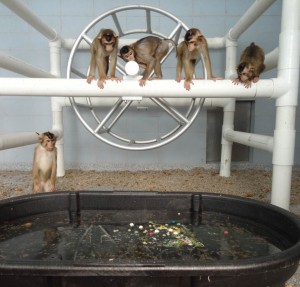Roles and Responsibilities
Behavioral Management Services (BMS) is part of the WaNPRC Division of Primate Resources and is tasked with assuring the psychological well-being of the nonhuman primates housed at the Center. The overarching goal of Primate Resources is to provide an optimal environment for conducting biomedical research at the WaNPRC. In order to assure the psychological well-being of the animals housed at our center, BMS oversees the implementation of the WaNPRC Environmental Enhancement Plan.

BMS also monitors and treats any abnormal behaviors, should they arise, and trains all incoming personnel regarding the Environmental Enhancement Plan, nonhuman primate behavioral ecology and how to behave while in the vivarium to avoid causing undue stress to the animals. BMS has a dedicated trainer that utilizes positive reinforcement training techniques to encourage a variety of behaviors including voluntary cooperation with various research and veterinary procedures. Voluntary cooperation not only increases the well-being of the animals by decreasing stress that can be associated with these procedures it also increases the safety of personnel working with the animals. All species of NHPs housed at our facility live in large social groups in the wild and social contact is best way to enrich the lives of our NHPs as well avert and ameliorate any problematic behavior. Therefore, one of the most important aspects of our behavioral management program is providing a compatible social partner to all animals that are allowed to have one. BMS also monitors ongoing compatibility in social pairs.
Research Conducted by Behavior Management Services
Behavioral management programs at all National Primate Research Centers have another mission that is less well known. They are charged with contributing to the establishment of professional standards for animal care through research, publication of experimental results in peer reviewed journals. We also present on our research at scientific meetings. Research topics are expected to include evaluation of environmental enhancement strategies, behavioral monitoring and treatment strategies as well as other aspects of the behavioral management program. The BMS research program at the WaNPRC has been especially productive during the last several years during which time members of the BMS team have been authors or co-authors on eight manuscripts that are published or in press in peer-reviewed journals. They have also been authors or co-authors on 19 talks and posters presented at national and international meetings.
BMS has evaluated toys and foraging devices utilized by the WaNPRC as well as aspects of structural enrichment such as shelves and wheels in the compounds. They have also evaluated the feasibility of providing water enrichment pools to compound-housed juveniles. A significant contribution to behavioral management strategies has been the development of an innovative and effective treatment for locomotor stereotypy involving access to increased vertical space. BMS has also undertaken an assessment of WaNPRC nursery rearing strategies by evaluating behavioral outcomes for juveniles as well as adults housed at our various facilities. Both studies found that animals reared in our nursery exhibited normal behavioral repertoires. BMS has also made significant contributions to the understanding of alopecia (hair loss) which poses a significant management challenge and has received increased attention by regulatory agencies in recent years. It had been commonly thought that the two primary causes of alopecia were attributable to hair plucking and stress. Studies conducted by BMS in collaboration with the Oregon and Southwest Primate Research Centers and the University of Massachusetts Amherst have found that the majority of animals with alopecia do not hair pluck. This collaborative study also found that alopecia was associated with significantly higher levels of hair cortisol (possibly indicative of stress) at one center, but unrelated to hair cortisol at two other centers. Studies at the WaNPRC have also shown that, in general, pigtail macaques exhibit more alopecia than rhesus macaques. Studies have also shown that animals purchased from different vendors have significantly different levels of alopecia depending on their facility of origin. These differences can persist for extended periods of time (up to 10 months after entry into our facility). Thus, taken together, these studies demonstrate that the etiology of alopecia is considerably more complicated than has been commonly thought. BMS is currently investigating effects of various ameliorative therapies on alopecia as well as pharmaceutic therapies for abnormal and atypical behaviors.
Julie Worlein | Research Scientist | Behavioral Management Services